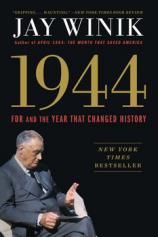1944: FDR and the Year That Changed History
Review
1944: FDR and the Year That Changed History
“Anne Frank didn’t know --- nor did the Jews of Hungary, nor, for that matter, did Roosevelt or Churchill --- that on D-Day both British and American intelligence were poring over air reconnaissance photos: photos that showed in chilling detail the buildings at the main camp of Auschwitz.”
This triangulated tale of a single year is brilliantly carried through by bestselling author/historian Jay Winik (APRIL 1865, THE GREAT UPHEAVAL). 1944 presents Franklin Delano Roosevelt, increasingly burdened by physical handicaps and illness yet consistently guiding his country through a war whose outcome was critical to the way the world would look for centuries hence. It reveals the Allies, especially Europe’s Jews, suffering that war and the evils of Adolf Hitler’s monstrous policies, along with “little people” seen in close-up, like Anne Frank, Jan Karski and Rudolf Vrba --- all destined to provide eyewitness accounts of those policies, that suffering.
"More than a chronicle, far more dramatic and immediate than a mere historical account, Winik’s tome is bound to evoke painful memories, arouse old controversies and strike a chorus of patriotism."
In early 1944, the Nazis started work on the Final Solution, a maniacal scheme to rid Europe of every single Jew. Railroad lines, built by the prisoners of Auschwitz, would lead straight to the gas chambers, “no need for trucks, no need for selections.” Word of the massive scope of the plan gradually leaked to Britain and the US. Deeply troubled, Roosevelt gave full credence to reports by sources like Polish underground operative Karski and German industrialist Eduard Schulte, but he did not publicly speak about what he knew, leaving some Americans in doubt as to the extent of the horrors being perpetrated. The military, under Roosevelt’s watchful eye, responded resoundingly on June 6th --- D-Day.
During the second half of the year, the desperate Nazis rushed to hide their perfidies, wiping out all remaining traces of Jewish resistance in the Warsaw ghetto. Anne Frank and her sister died in Bergen-Belsen concentration camp. The Allies drew closer by agonizing increments to their goal of the total liberation of Europe, and President Roosevelt was elected for a fourth time, though he would serve only a few months of that term. 1944 telescopes to the early months of 1945 to cover Roosevelt’s demise and the waning days of the war.
The book is painted by Winik in grand strokes of action well known to us all, and in poignant small cameos playing out simultaneously. Take, for example, the experience of Peter Coombs, an Allied soldier, viewing “a carpet of dead bodies” as British and American troops entered the camps and confirmed what had been reported earlier. Winik starkly records that prisoners “were ravenous for Americans,” eating, rather than smoking, the cigarettes the soldiers proffered, some so ill they died from trying to consume the GIs’ innocent gift of chocolate bars. Meanwhile, Adolf Eichmann “was strutting about visiting Theresienstadt one more time” --- and Roosevelt was scant days from death.
More than a chronicle, far more dramatic and immediate than a mere historical account, Winik’s tome is bound to evoke painful memories, arouse old controversies and strike a chorus of patriotism. It ends on a subtle note as thought-provoking as it is radical: “Seventy years later, around the globe, we are still struggling to answer the question whispered through the Nazi camps: When will the Allies come? When will the Americans come?”
Reviewed by Barbara Bamberger Scott on September 25, 2015
1944: FDR and the Year That Changed History
- Publication Date: September 27, 2016
- Genres: History, Nonfiction
- Paperback: 656 pages
- Publisher: Simon & Schuster
- ISBN-10: 1501125362
- ISBN-13: 9781501125362





